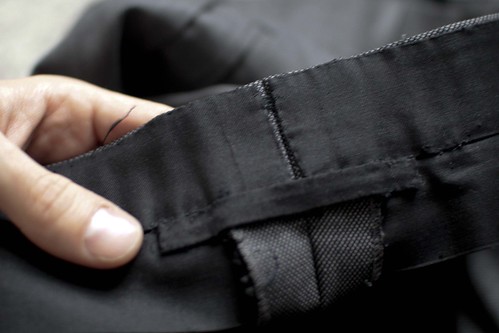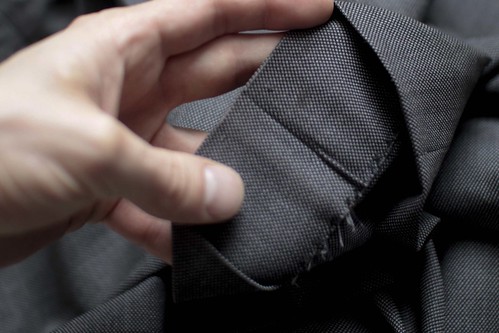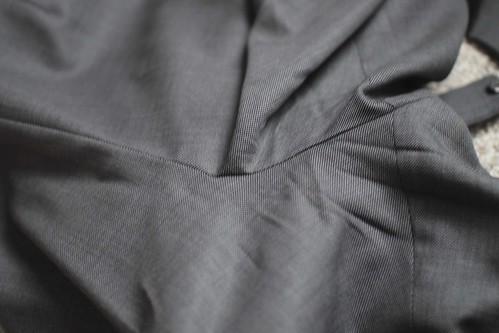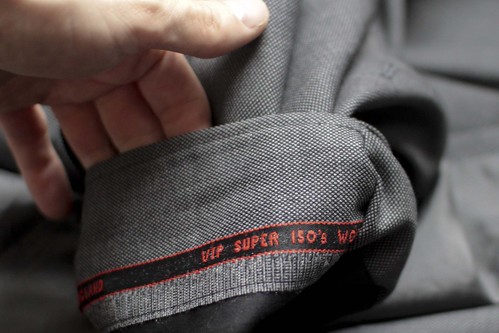
The next suit to be dissected is an old bespoke number; made back in 1992, it has clearly been worn. Hard.
There is evidence of the waist having been let out
but more telling is this- the owner wore right through the knee lining. 
If I look at the areas of the garment which show the most stress, namely the hem of the trouser (including the inside), the sleeve hem and the seat area, this will give me an idea of how well this particular cloth performed.
THe hem of the trouser is in almost perfect condition
even on the inside
The sleeve hem shows almost no signs of wear
and neither does the seat of the trouser.
It is quite safe to assume that this is a sturdy, English cloth. But what is surprising about this particular cloth is how fine it is.
That's right, Super 150s.
One of the common myths among the iGentry is that cloths of high super-numbers (which is an indication of how fine the fibers that were used to weave the cloth are, measured in microns) are too fragile and won't hold up to wear. While some cloths (notably Italian cloth) are made up with the intent of being very fine, soft and lightweight, and thus are more fragile, it is not necessarily true that all cloths bearing high super-numbers will be fragile. This garment being a fine example (in every respect).
So when evaluating the merits of a particular cloth, please do not fall into the ill-informed trap of dismissing a cloth merely because it is made up from super-fine yarns and must, therefore, be too fragile; let your tailor, who knows how various types of cloth handle and perform, guide you instead.








10 comments:
I've seen something similar in an old H. Freeman suit that I thrifted. It's an old model (Philadelphia made, IIRC) and the previous owner put a LOT of mileage on it, so much that the inside lining is in need of replacement and worn clean through in many places. The outside is in near perfect condition as it's made in a nigh bulletproof charcoal worsted (quite befitting it's sack cut).
Are there any indications as to the maker of this cloth or where it can be had?
The cloth is from Gladson, who represent a number of mills, but it was 20 years ago so it may not still be available.
Amazing. What way, that you know of is the best way to tell how well a fabric will hold up over time?
Wear it for a long time and see how it did!
But seriously, your tailor should be able to guide you from experience. And if you're really super-concerned, you could send a swatch out to one of the testing labs that the RTW uses to test tensile strength, shrinkage, crocking, etc.
But, as you didn't say, the super number does not tell us the length of the fibers spun into the yarn, how tightly they were twisted, the type of weave, the skill of the mill, etc. -- though I know you are well aware of all that and more.
How is life here in Chicago?
jb (Despos client)
Who made the suit?
@jb- absolutely. All things which are not woven into the selvedge and so you are best to rely on the advice of your tailor. You wouldn't happen to be the Joel with whom I had exchanged a few messages on LL before it imploded? if so, glad to know you are still around, and I hope to be able to take you up on your invitation soon.
@Anonymous- the suit was made by Chris Despos.
:)
Thanks for guiding us, Master Tailor. Appreciate each and every one of your tutorials, Jeffery.
Kim
Jeffery,
It is indeed me. Check your email.
jb
That is why it is necessary to have the tensile strength of a fabric stated, so that one knows while investing in expensive fabrics.If very fine fabric is used in a compacted manner while weaving, say two ply or three ply, it may lead to greater strength.
Post a Comment